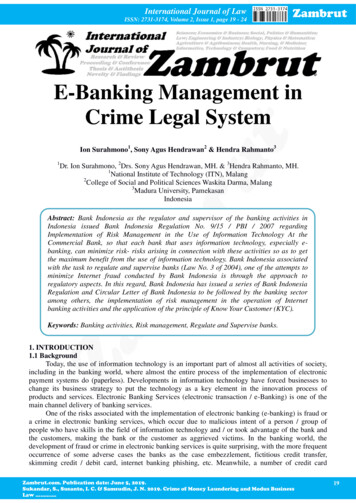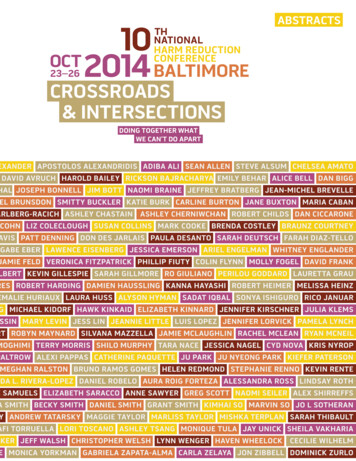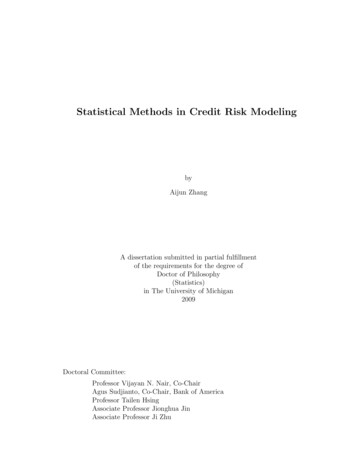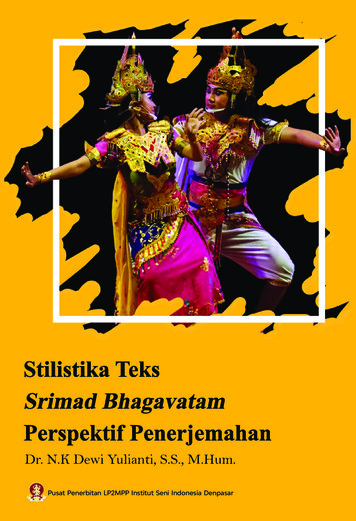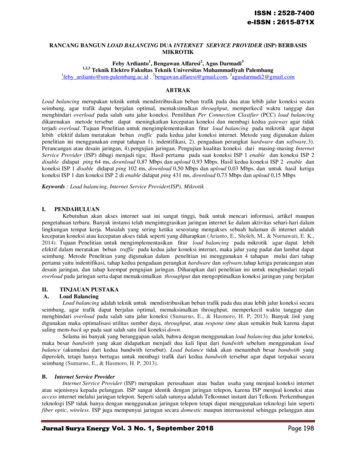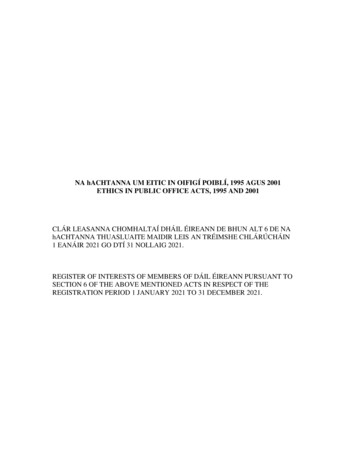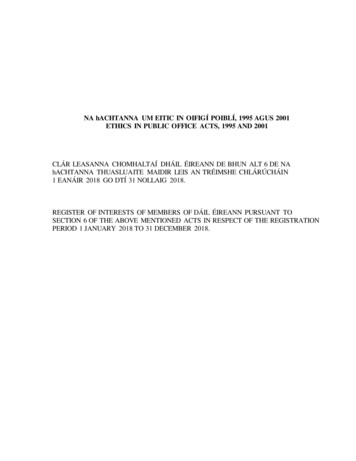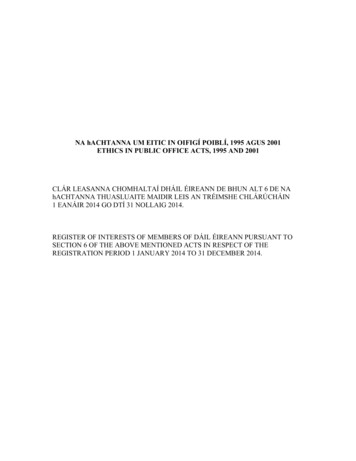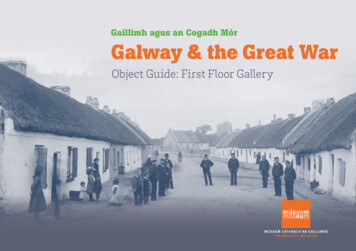
Transcription
Gaillimh agus an Cogadh MórGalway & the Great WarObject Guide: First Floor Gallery
“The men are as anxious for the road, sir, as if‘twere to Galway races they were going, no less,or to Ballinasloe Fair”In the Trenches with the Connaught Rangers by Michael MacDonagh (1917)“In a matter of seconds, a hissing and shriekingpandemonium broke loose. The sky was splashedwith light. Rockets, green, yellow and red, dartedin all directions; and simultaneously, a cyclone ofbursting shells enveloped us.”Galway & the Great War Gaillimh agus anMore than 200,000 Irishmen served in the BritishCogadh Mórarmy during the Great War of 1914 to 1918. Over30,000 of these men were killed in the line of duty,including at least 750 Galway men. Wars, however,are not just about statistics but about people, thoseon the front line and those left behind.This exhibition explores the stories behind thestatistics through personal accounts, objects andletters. If you would like to share your own storyrelating to Galway and the Great War, please leaveyour name and contact details at Reception.Rinne breis agus 200,000 Éireannach seirbhísin arm na Breataine idir 1914 agus 1918, bliantaan Chogaidh Mhóir. Maraíodh breis agus 30,000duine de na fir sin agus iad ar dualgas, 750Gaillmheach ar a laghad ina measc. Ní bhaineanncogaí le staitisticí amháin, áfach. Tá daoine, idirdhaoine ar an líne thosaigh agus dhaoine a fágadhina ndiaidh, i gceist leo freisin.Sa taispeántas seo, déantar iniúchadh ar na scéaltataobh thiar de na staitisticí trí chuntais, rudaí aguslitreacha na ndaoine. Más mian leat do scéal féin abhaineann le Gaillimh agus an Cogadh Mór a insint,fág d’ainm agus do shonraí teagmhála ag an oifigfáilte.J.F.B. O’Sullivan, 6th Connaught RangersImage creditsCover: Courtesy of NLIFar left: Courtesy of Greg Quinn & theLynskey familyLeft (thumnail images): courtesy of NGI, NLI,R. Morris, J. Corcoran & T McDonagh & SonsBack page: courtesy of T. KennyAll other images: Galway City Museum23
‘Brodie’ HelmetClogad ‘Brodie’Steel British Army issue ‘Brodie’ helmet (named after its inventor, engineerJohn Leopold Brodie) which was used during the Great War. The helmet wassecured using a leather chin strap. Originally a green colour, the helmets werepadded on the inside, making them more comfortable to wear. Nicknamed the‘Battle Bowler’ this helmet provided protection from ammunition or debristhat fell into the trenches.Eisiúint chlogad chrua ‘Brodie’ de chuid Arm na Breataine (ainmnithe asa cheapadóir, an t-innealtóir John Leopold Brodie) a úsáideadh le linn anChogaidh Mhóir. Cheangailtí an clogad le smigiris leathair. Bhí dath glasar na clogaid ar dtús, agus iad stuáilte ar an taobh istigh, á ndéanamh níoscompordaí le caitheamh. Agus an leasainm ‘Battle Bowler’ air chuireadh anclogad seo cosaint ar fáil ó urchair nó ó smionagar ar bith a thiteadh isteachsna trinsí.This particular helmet was used by a member of the ‘Black and Tans’ whowere recruited by the British Government to support the Royal IrishConstabularly (RIC) in suppressing the republican movement in Ireland. Thename ‘Black and Tans’ derived from the tan and black uniforms they wore.Between early 1920 and the Anglo-Irish Truce in July 1921, almost 14,000‘Black and Tan’ recruits, including many Great War veterans, served in Irelandwhere they earned a reputation for violence and brutality against the civilianpopulation. They were disbanded in 1922 with the formation of the Irish FreeState.Donated to Galway City Museum by Jim Higgins, GalwayBhíodh an clogad faoi leith seo á úsáid ag ball de ‘na Dúchrónaigh’ (Blackand Tans) a d’earcaigh Rialtas na Breataine chun tacú le ConstáblachtRíoga na hÉireann (RIC) chun gluaiseacht na poblachta in Éirinn a churfaoi chois. Tháinig an t-ainm ‘na Dúchrónaigh’ (Black and Tans) ón éidechrón agus dhubh a bhíodh á chaitheamh acu. Idir tús 1920 agus an SosCogaidh Angla-Éireannach in Iúil 1921, bhí beagnach 14,000 earcach dechuid ‘na nDúchrónach’, lena n-áirítear a lán iarshaighdiúirí de chuid anChogaidh Mhóir, in Éirinn, áit ar bhain siad clú amach as a bhforéigean agusa mbrúidiúlacht in éadan an phobail shibhialtaigh. Díscaoileadh iad i 1922nuair a bunaíodh Saorstát Éireann.Bronnta ar Mhúsaem Cathrach na Gaillimhe ag Jim Higgins, Gaillimh4Lee-Metford 303 RifleRaidhfil 303 Lee-MetfordThe bolt action Lee-Metford rifle was adopted by the British Army in 1888and used until 1926. Weighing nine pounds it was sighted to 1,200 yards andheld 8-10 rounds of ammunition (10 round capacity was developed in 1893).The ‘Lee’ comes from James Paris Lee, a Scottish-born, Canadian, firearmsdesigner who invented the ‘bolt action’ rifle whereby the user lifted a bolt sothat a cartridge moved from the magazine into the gun and allowed for fastershooting of up to 30 shots a minute – instead of each cartridge having to beloaded by hand. This rifle combined Lee’s quick firing design with a barrelrifling method developed by Col. William Ellis Metford – hence the name LeeMetford.Ghlac Arm na Breataine raidhfil boltála Lee-Metford i 1888 agus bhí sé á úsáidacu go dtí 1926. Agus é naoi bpunt meáchain bhíodh sé treoráilte go 1,200slat agus é in ann idir 8-10 n-urchar a choinneáil (bunaíodh an acmhainn10 n-urchar i 1893). Tagann an ‘Lee’ ó James Paris Lee, dearthóir airm thine,Ceanadach a rugadh in Albain. Cheap sé an raidhfil boltála trína dtógadh ant-úsáideoir bolta ionas go mbogadh cartús ón bpiléarlann isteach sa ghunnaagus lenar rabhthas ábalta urchair a scaoileadh níos gaiste - suas le 30 urcharin aghaidh an nóiméid - seachas gá a bheith le gach cartús a lódáil de láimh.Chomhcheangail an raidhfil seo dearadh mearlámhaigh Lee le modh raidhfilbairille a d’fhorbair an Maor William Ellis Metford – agus sin é an fáth artugadh Lee-Metford uirthi.Loan from Renmore Barracks Museum, Galway.Iasacht ó Mhúsaem Bheairic na Rinne Móire, Gaillimh.5
Bayonet and ScabbardBeaignit agus TruaillWebley RevolverGunnán WebleyBayonet and scabbard recovered from a house in Henry St, Galway and whichpossibly belonged to local man Patrick Naughton. The bayonet is a BritishPattern 1888 made to fit onto the barrel of a Lee-Metford Infantry rifle foruse during close combat. The crown and ‘VR’ marked on the blade refer toQueen Victoria who reigned in Britain from 1837-1901, while the ‘WD’ onthe underside indicate it was checked and approved by the War Department.This type of bayonet was used up to and during the Great War.Beaignit agus truaill a fuarthas i dteach i Sráid Anraí, Gaillimh agus ar dhóchagurbh le fear áitiúil Patrick Naughton é. Patrún de chuid na Breataine 1888is ea an bheaignit a rinneadh lena fheistiú ar bhairille raidhfil de chuidChoisithe Lee-Metford lena úsáid le linn comhraic. Tagraíonn an choróinagus an ‘VR’ atá marcáilte ar an lann don Bhanríon Victoria a bhí i réimsa Bhreatain ó 1837-1901, agus léiríonn an ‘WD’ ar an taobh íochtair gursheiceáil agus gur fhaomh Rannóg an Chogaidh é. D’úsáidtí an cineál seobeaignite sa tréimhse suas go dtí an Cogadh Mór agus le linn an ChogaidhMhóir.The Webley Mark VI revolver was manufactured by P. Webley & Son,Birmingham, England, founded in 1790. It became their best-known model,and was standard British Army issue, being officially adopted in 1915, withover 300,000 revolvers produced for service. A powerful weapon, the WebleyMark VI was used until 1932 – being distinguished from earlier Webleyswith a 6-inch rather than 4-inch barrel and a square butt. The Mark VI wasreplaced by the Enfield No 2 revolver and was officially retired as obsolete in1947. This particular gun was captured c. 1920 from British soldiers attendinga social event at Taylor’s Hill, Galway by Irish Volunteers involved in the Warof Independence (1919-1921).Ba é P. Webley & Son, Birmingham, Sasana, a bunaíodh i 1790, a rinne angunnán Webley Marc VI. Ba é a dhéanamh ab fhearr a raibh eolas air, agusba eisiúint chaighdeánach Arm na Breataine é, ar glacadh leis go hoifigiúili 1915. Táirgeadh os cionn 300,000 gunnán le haghaidh na seirbhíse. Armcumhachtach, úsáideadh an Webley Marc VI go dtí 1932 - idirdhealaithe óWebley ar bith ní ba luaithe le bairille 6 orlach seachas bairille 4 orlach agusbota cearnógach. Tháinig gunnán Enfield Uimh. 2 in ionad Mharc VI aguscuireadh as feidhm é mar cheann a bhí rite as cineál i 1947. Ghabh Óglaigh nahÉireann a bhí páirteach i gCogadh na Saoirse (1919-1921) an gunna ar leithseo thart ar 1920 ó shaighdiúirí de chuid na Breataine a bhí ag freastal ar ócáidshóisialta ag an mBóthar Ard .Loan from Tommy Hynes, Galway.Iasacht ó Tommy Hynes, Gaillimh.Donated to Galway City Museum by Seán Crowe, Waterford.6Bronnta ar Mhúsaem Cathrach na Gaillimhe ag Seán Crowe, Port Láirge.7
Collection of Bernard FahyMemorabiliaBailiúchán d’Earraí CuimhneacháinBernard FahyBernard or ‘Bernie’ Fahy was born on 26 September 1890, son of Richard andEllen Fahy of Cregboy, Claregalway, Galway. He emigrated to New Zealandc. 1912 and in October 1915 enlisted with the New Zealand TunnellingCompany. Bernard arrived in France in March 1916 and was involved inthe development of a large network of underground tunnels around thetown of Arras. On 19 April 1917 he was killed by German shell fire along theArras-Cambrai Road, around Tilloy-lès-Mofflaines, France, and is buried atFaubourg d’Amiens Cemetery, Arras, France .Rugadh Bernard nó ‘Bernie’ an 26 Meán Fómhair 1890, mac do Richard agusEllen Fahy, an Chreig Bhuí, Baile Chláir, Gaillimh. Chuaigh sé ar imirce go dtían Nua-Shéalainn thart ar 1912 agus i nDeireadh Fómhair 1915 liostáil sé leCuideachta Tollánaithe na Nua-Shéalainne. Tháinig Bernie chun na Fraincei Márta 1916 agus bhí sé páirteach i bhforbairt líonra mór tollán faoi thalamhthart ar bhaile Arras. Maraíodh é an 19 Aibreán 1917 le lámhach sliogán dechuid na Gearmáine ar feadh Bhóthar Arras-Cambrai Road, thart ar Tilloylès-Mofflaines, an Fhrainc, agus tá sé curtha i Reilig Faubourg d’Amiens,Arras, an Fhrainc.L’imitations of Jesus-Christ published by Gaume Frères et J. Duprey, Libraires,4 Rue Cassette. There are two inscriptions on the interior - the name GeorgeLileu who is probably the original owner of the book and ‘found on the battlefield by Bernard Fahy 1914-1918’.Letter from Sergeant Major T. P. Walsh to Bernard’s mother informing her ofhis death and dated 28 April 1917. Photo of grave where Bernard was buried.Postcard from Bernard to his sister ‘Nannie’ describing life at the Front whichis dated 10 December 1916A New Zealand postcard to Bernard life at home – not signed or dated bysender.Loan from Peter Kelly, Galway.L’imitations of Jesus-Christ arna fhoilsiú ag Gaume Frères et J. Duprey,Libraires, 4 Rue Cassette. Tá dhá inscríbhinn ar an taobh istigh - ainm GeorgeLileu ar dócha gurb é úinéir bunaidh an leabhair é agus ‘found on the battlefield by Bernard Fahy 1914-1918’.Litir ón Maorsháirsint T.P. Walsh chuig Máthair Bernard ag insint di faoinabhás agus í dátaithe an 28 Aibreán 1917. Grianghraf den uaigh ina bhfuilBernard curtha.Cárta poist ó Bernard chuig a dheirfiúr ‘Nannie’ ag cur síos ar an saol ag anbhFronta agus í dátaithe an 10 Nollaig 1916.Cárta poist chuig Bernard ag cur síos ar an saol sa bhaile - níl sé sínithe nódátaithe ag an seoltaí.Iasacht ó Peter Kelly, Gaillimh.Irish Guards DrumDruma na Irish GuardsThe Irish Guards were founded by order of Queen Victoria on 1 April 1900 andwere based at Mons Barracks, Aldershot, England. The establishment of theregiment was in recognition of the many Irish soldiers who took part in theSecond Boer War (1899-1902).Bunaíodh na Irish Guards le hordú ón mBanríon Victoria an 1 Aibreán 1900 agusbhí siad bunaithe ag Beairic Mons, Aldershot, Sasana. Bunaíodh an reisimintin aitheantas ar an gcuid mhór saighdiúirí Éireannacha a ghlac páirt i nDaraCogadh na Bórach (1899-1902).Just before the Great War, John Redmond, an Irish nationalist MP, presenteda new set of drums to the Irish Guards. The old drums were presented to theofficers, one of those being George Henry Morris. Drums were often played byyounger boys during battles and ceremonial events. They have been used inbattles throughout history as a device for signalling instructions, maintainingmorale of the soldiers and attracting recruits.Díreach roimh an gCogadh Mór, bhronn John Redmond, FP náisiúnachÉireannach, foireann úr drumaí ar na Irish Guards. Bronnadh na sean-drumaíar na hoifigigh, agus ba é George Henry Morris duine díobh sin. Bhuaileadh nabuachaillí óga na drumaí go minic le linn cathanna agus ócáidí searmanais.D’úsáidtí iad i gcathanna ar feadh na mblianta mar ghléas le haghaidh treorachacomharthaíochta, a choinníodh meanma na saighdeoirí agus a mhealladhearcaigh.Loan from the Morris family, Dublin.Iasacht ó Chlann Mhic Mhuiris, Baile Átha Cliath.Cigarette case, match box andtobacco case which belonged toGeorge Henry MorrisCás toitíní, bosca cipíní agus cástobac arbh le George Henry MorrisiadWhile cigarettes were available from the late 19th century, it was not until theGreat War that they became popular. Up until then pipe smoking was preferred.In the trenches of war the ready-rolled cigarette was more convenient, as pipescould fall and break. During the war, soldiers were issued with weekly rationsof up to 2oz of tobacco which was thought to ‘boost morale and calm nerves’.Cigarettes became one of the most frequently requested ‘comforts’ for men of allranks at the Front. British soldiers and sailors smoked 1,000 tons of cigarettesand 700 tons of pipe tobacco in 1915.Cé go raibh toitíní ar fáil ó bhí deireadh an 19ú haois ann, ní raibh tóir orthu go dtítráth an Chogaidh Mhóir. Suas go dtí sin ba é an píopa is mó a bhíodh ag daoine.Bhí toitíní ré-rollta ní b’áisiúla sna trinsí cogaidh toisc go bhféadfadh na píopaítitim agus briseadh. Le linn an chogaidh, thugtaí ciondálacha seachtainiúla suasle 2 unsa tobac do shaighdeoirí agus cheaptaí go ndéanadh sé sin ‘an meanmaa threisiú agus na néaróga a shuaimhniú’. Ba iad toitíní ba mhinice a d’iarrtaímar ‘shó’ d’fhir ó gach uile aicme ag an bhFronta. Chaith saighdeoirí agusmairnéalaigh de chuid na Breataine 1,000 tona toitín agus 700 tona tobac píopai 1915.‘If the men can only get a ‘fag’ or a pipe they are content. They pay no heed todiscomfort in the trenches, or on the march in the worst weather. Even if theyare without their rations they won’t complain if ‘fags’ don’t fail. Some have beenreduced to smoking their allowances of tea. Others have smoked brown paper orleaves of trees.’ (Quote from an officer, published in a volume of The Bystander).8Loan from the Morris family, Dublin.‘If the men can only get a ‘fag’ or a pipe they are content. They pay no heed todiscomfort in the trenches, or on the march in the worst weather. Even if theyare without their rations they won’t complain if ‘fags’ don’t fail. Some have beenreduced to smoking their allowances of tea. Others have smoked brown paper orleaves of trees.’ (Sliocht ó oifigeach, foilsithe in imleabhar de The Bystander).Iasacht ó Chlann Mhic Mhuiris, Baile Átha Cliath.9
Shell from the Galway National Shell Sliogán ón Monarcha NáisiúntaFactorySliogán i nGaillimhThe first artillery shell made in the Galway National Shell Factory in 1917. Thefactory, whose work force was mainly women, produced 18-pound shells for usein the Great War. The factory building, which later became the Irish MunitionsIndustries Ltd. still survives in part on the grounds of the National University ofIreland, Galway.The inscription on the shell reads:Galway National Shell FactoryThe first shellmanufactured12-2-1917Presented toMartin McDonogh Esq.During the war, five ‘national munitions factories’ were set up in Dublin(which had two), Cork, Waterford and Galway, employing 2,148 men andwomen. In Galway, a local committee, which included Martin Mór McDonaghwith support from the Urban District Council, County Council and HarbourBoard lobbied the Ministry of Muntions in Britain (with support from JohnRedmond MP) to establish a factory in Galway. By July 1916 plans for thefactory were in place. The first shell was produced under the supervision ofCaptain Downie, chief expert of the muntions ministry in Ireland. The factoryemployed 115 people, working three eight-hour round the clock shifts. Themajority of the workforce (95%) was female as per governmental regulations.Many of the factory women joined the National Federation of WomenWorkers (NFWW) who campaigned for worker’s rights and wages in linewith Britain for similar work. The end of the war signalled the closure of thefactories.Galway City Museum CollectionAn chéad sliogán airtléire a rinneadh sa Mhonarcha Náisiúnta Sliogáni nGaillimh a d’oscail i 1917. Rinneadh sliogáin 18 bpunt sa mhonarcha,ina raibh mná den chuid ba mhó ag obair inti, lena n-úsáid sa ChogadhMór. Maireann cuid d’fhoirgneamh na monarchan, a ndearnadh na IrishMunitions Industries Ltd. di níos déanaí, ar thailte Ollscoil na hÉireann,Gaillimh fós.Léitear é seo a leanas ar inscríbhinn an tsliogáin:Galway National Shell FactoryThe first shellmanufactured12-2-1917Presented toMartin McDonogh Esq.Le linn an chogaidh, bunaíodh cúig ‘mhonarcha náisiúnta muinisean’i mBaile Átha Cliath (ina raibh dhá cheann), Corcaigh, Port Láirge agusGaillimh, ina raibh 2,148 duine, idir fhir agus mhná, fostaithe. Rinne coisteáitiúil i nGaillimh, ar a raibh Máirtín Mór McDonagh agus le tacaíocht óngComhairle Ceantair Uirbigh, ón gComhairle Contae agus ó Bhord na gCuanta,bolscaireacht leis an Aireacht Muinisean sa Bhreatain (le tacaíocht ó JohnRedmond FP) chun monarcha a bhunú i nGaillimh. Faoi mí Iúil 1916 bhí napleananna don mhonarcha curtha i bhfeidhm. Táirgeadh an chéad sliogánfaoi mhaoirseacht an Chaptaein Downie, príomhshaineolaí na haireachtamuinisean in Éirinn. Bhí 115 dhuine fostaithe sa mhonarcha, agus d’oibrídístrí shealanna ocht n-uaire de lá agus d’oíche. Mná a bhí i bhformhór nan-oibrithe (95%) de réir rialacháin an rialtais. Chuaigh a lán de mhná namonarchan isteach san National Federation of Women Workers (NFWW) (anFhondúireacht Náisiúnta d’Oibrithe Ban) a bhí i mbun feachtais le haghaidhcearta oibrithe agus pá ar aon dul leis an mBreatain le haghaidh obair denchineál céanna. Dúnadh na monarchana nuair a chríochnaigh an cogadh.Bailiúchán Mhúsaem Cathrach na Gaillimhe1011
Clay PipesTram SeatBefore the introduction of the cigarette to Ireland in 20th century it was common for men and women to smoke claypipes. The long-stemmed pipes were commonly passed around at wakes and consequently became known as ‘Lordha’ mercy’ pipes. The short-stemmed pipe was favoured by the working class as it was short and light. These wereknown as ‘dúidíns’ in Ireland, ‘cuttys’ in Scotland and ‘nose warmers’ in parts of England.The Galway-Salthill tram line opened on 1 October 1879. Operated by the GalwaySalthill Tramway Company, the tram left from the depot at Forster Street, travelling toEyre Square; onto Williamsgate St; William St; Shop St; Mainguard St; Bridge St; LowerDominick St; Sea Road and past Nile Lodge before its terminus at the Eglinton Hotel inSalthill. Both single and double-decker, horse-drawn trams were used, with the lattercarrying up to 36 passengers. The tram ran every weekday from 6am to accommodateworkers.The clay pipe was often used to express political or social allegiance. They are decorated with the Irish nationalemblems: harp and shamrock. The words ‘Home Rule for Ireland’ also feature prominently indicating certainpolitical ideals of the time. Home Rule was a policy devised by Isaac Butt in the 1870s with the aim of establishinga parliament in Dublin, separate from London, to legislate for Irish affairs. On 18 September 1914, the Governmentof Ireland Act, which provided for Home Rule, was finally passed in Parliament but was suspended for the durationof the Great War. John Redmond, leader of the Irish Parliamentary Party, believed that support from Ireland wouldspeed up both the end of the war and the introduction of Home Rule. With that, he pledged the support of the IrishVolunteers to the war effort. Between 1914 and 1918, 150,000 or so Irish men enlisted in the British Army. Irelandnever achieved Home Rule - the legislation was superseded by the Anglo-Irish Treaty in 1922 following the War ofIndependence and the establishment of the Irish Free State.In 1881 the fare between Eyre Square and Nile Lodge was one penny, and the farebetween Nile lodge and Salthill was another penny. Drivers were paid fifteen shillingsper week. The tramway company ran into difficulties during the Great War when mostof the horses were commandeered by the British government as part of the war effort.The company eventually disbanded in 1918. Alternative public transport was providedby the Galway General Omnibus Company which ran buses from 1919.Galway City Museum CollectionGalway City Museum CollectionPíopaí CréSular tugadh an toitín isteach go hÉirinn sa 20ú haois ba ghnáthrud é d’fhir agus do mhná píopaí cré a chaitheamh.Chuirtí na píopaí fadchosacha thart ag tórraimh de ghnáth agus dá réir sin thugtaí píopaí ‘Lord ha’ mercy’ (‘aThiarna déan trócaire’) orthu. Ba é an píopa garchosach ba mhó a thaitin le hoibrithe toisc go raibh sé gearr aguséadrom. Thugtaí na ‘dúidíní’ orthu seo in Éirinn, ‘cuttys’ in Albain agus ‘nose warmers’ i gcodanna de Shasana.12D’úsáidtí an píopa cré go minic chun dílseacht pholaitiúil nó shóisialta a chur in iúl. Tá siad maisithe le suaitheantaisnáisiúnta na hÉireann: an chláirseach agus an tseamróg. Tá na focail ‘‘Home Rule for Ireland’ (Rialtas Dúchaisd’Éirinn) marcáilte go suntasach chomh maith, rud a léiríonn idéil pholaitiúla áirithe na ré sin. Beartas ab ea RialtasDúchais a cheap Isaac Butt sna 1870í agus ba í an fheidhm a bhí leis parlaimint a bhunú i mBaile Átha Cliath, amachas féin ó Londain, chun reachtaíocht a dhéanamh do ghnóthaí na hÉireann. Ritheadh Acht um Rialú na hÉireann,ina raibh foráil do Rialtas Dúchais, ar deireadh sa Pharlaimint an 18 Meán Fómhair 1914, cé gur cuireadh ant‑acht ar fionraí ar feadh thréimhse an Chogaidh Mhóir. Chreid John Redmond, ceannaire Pháirtí Parlaiminteachna hÉireann, go dtiocfadh deireadh ní ba luaithe leis an gcogadh agus go dtabharfaí isteach Rialtas Dúchais níba luaithe dá dtacódh Éire leis an mBreatain. Leis sin, gheall sé tacaíocht ó Óglaigh na hÉireann d’iarrachtaí anchogaidh. Idir 1914 agus 1918, liostáil 150,000 nó níos mó Éireannach in Arm na Breataine. Níor cuireadh RialtasDúchais i bhfeidhm in Éirinn riamh. Tháinig an Conradh Angla-Éireannach i bhfeidhm in ionad na reachtaíochtasin i 1922 tar éis Chogadh na Saoirse agus bhunú Shaorstát Éireann.Bailiúchán Mhúsaem Cathrach na GaillimheSuíochán TramOsclaíodh trambhealach na Gaillimhe-Bhóthar na Trá an 1 Deireadh Fómhair 1879. Bhísé á oibriú ag Cuideachta Trambhealaigh na Gaillimhe-Bhóthar na Trá, d’imíodh sé óniosta ag Sráid Forster, go dtí an Fhaiche Mhór; ar aghaidh go dtí Sráid Gheata Liam; SráidLiam; Sráid na Siopaí; Sráid an Phríomhgharda; Sráid an Droichid; Sráid DhoiminicÍochtarach; Bóthar na Mara agus thar Lóiste na Níle roimh a stáisiún ceann aistir agÓstán Eglinton i mBóthar na Trá. D’úsáidtí tramanna capalltarraingthe aon urláir agusdhá stór araon, agus bhíodh suas le 36 phaisinéir á n-iompar ar an dara ceann. Bhíodhan tram ag imeacht gach lá den tseachtain ó 6am chun freastal ar lucht oibre.In 1881 bhí an táille idir an Fhaiche Mhór agus Lóiste na Níle pingin amháin, agus bhían táille idir Lóiste na Níle agus Bóthar na Trá pingin eile. D’íocaidís cúig scilling déag letiománaithe in aghaidh na seachtaine. Bhí deacrachtaí ag cuideachta an trambhealaighle linn an Chogaidh Mhóir nuair a ghabh rialtas na Breataine formhór na gcapall marchuid d’iarracht an chogaidh. Díscaoileadh an chuideachta ar deireadh in 1918. ChuirCuideachta Omnibus General na Gaillimhe a chuir busanna ar fáil ó 1919 iompar poiblíeile ar fáil.Bailiúchán Mhúsaem Cathrach na Gaillimhe13
Connaught Rangers DressHelmet and JacketMellows’ CaneWalking cane which reputedly belonged to Liam Mellows (1895-1922). Mellows led the onlysignificant revolt in Connacht during the 1916 Rising, directly east of Galway city. He was amember of the Irish Republican Brotherhood and had been sent from Dublin to re-organise and trainVolunteers in Galway prior to the 1916. On Tuesday 25 April 1916 Mellows orchestrated attacks on theRoyal Irish Constabularly (RIC) Barracks in Clarinbridge, Oranmore and Athenry. The rebels couldnot compete with the resources of the RIC and British Army and retreated to Moyode Castle and ontoLimepark, near Peterswell, Gort, Co. Galway. Most of the rebels had returned to their homes by thefollowing Saturday. Mellows, as a ‘wanted man’, escaped to Co. Clare where he lived in hiding for a timebefore fleeing to Cork and onto the United States. During the Civil War, Mellows allegiance was withthe anti-Treaty side. On 8 December 1922, he was one of four men executed by the Irish Free Statewithout a trial, as a reprisal for the killing of Seán Hales, a pro-Treaty TD.Loan from Renmore Barracks Museum, Galway.Maide Mellows14De réir an tseanchais maide siúil le Liam Mellows a bhí ann (1895-1922). Ba é Mellows a stiúir ant-aon éirí amach suntasach i gCúige Chonnachta le linn Éirí Amach 1916, díreach soir ó chathairna Gaillimhe. Bhí sé ina bhall de Bhráithreachas Phoblacht na hÉireann agus cuireadh ó BhaileÁtha Cliath é chun na hÓglaigh i nGaillimh a atheagrú agus a chur faoi oiliúint roimh an éirí amachin 1916. Ar an Máirt, an 25 Aibreán, 1916 d’eagraigh Mellows ionsaithe ar Bheairic ChonstáblachtRíoga na hÉireann (RIC) i nDroichead an Chláirín, in Órán Mór agus i mBaile Átha an Rí. Ní raibh nareibiliúnaigh ábalta dul san iomaíocht le hacmhainní an RIC agus Arm na Breataine agus chúlaighsiad siar go Caisleán Mhaigh Fhód agus ar aghaidh go Baile na Creige, gar do Thobar Pheadair, an Gort,Co. na Gaillimhe. D’fhill formhór na reibiliúnach abhaile faoin Satharn ina dhiaidh sin. D’éalaighMellows, mar ‘fhear a rabhthas sa tóir air’, go Contae an Chláir áit ar chónaigh sé i bhfolach sular theithsé go Corcaigh agus ar aghaidh go dtí na Stáit Aontaithe. Le linn Chogadh na Saoirse, bhí Mellows inéadan an Chonartha. Ar an 8 Nollaig 1922, bhí sé ar dhuine de cheathrar fear a chuir Saorstát Éireannchun báis gan triail, mar bheart díoltais ar mharú Sheáin Hales, TD a bhí i bhfabhar an Chonartha.Iasacht ó Mhúsaem Bheairic na Rinne Móire, Gaillimh.The Connaught Rangers were formed in 1881 with theamalgamation of the 88th Regiment of Foot (known as theConnaught Rangers) and the 94th Regiment of Foot (formerlythe ‘Scotch’ Brigade). Nicknamed ‘The Devil’s Own’ their mottowas ‘Quis Separabit’ meaning ‘Who Shall Separate Us’. Over2,500 Connaught Rangers were killed in action or died fromtheir wounds during the Great War.The helmet is an example of the type conventionally adoptedby most regiments of the British Army from 1878. The designwas heavily influenced by the pickelhaube helmet (from theGerman ‘pickel’ meaning ‘point’ and ‘haube’ meaning ‘bonnet’)worn by the Prussian army from 1842 - the spike wasoriginally used to hold a plume of horsehair. The helmet wasworn as part of full formal dress, the curb chain being worn atthe chin whilst on official duty but then draped over the peakand suspended from the spike base on unoffical engagements.The badge features the Irish harp to represent Ireland andthe Crown to represent Britain. The inscription around theharp reads ‘HONI SOIT QUI MAL Y PENSE‘ from the Frenchmeaning ‘shame on him who thinks evil of it’.The dress jacket features embossed buttons with the insigniaof the Connaught Rangers and would have been worn withnavy trousers for formal events.The Connaught Rangers were disbanded in 1922 under theterms of the Anglo-Irish Treaty following the formation of theIrish Free State.Galway City Museum CollectionClogad agus SeaicéadGléasta na ConnaughtRangersBunaíodh na Connaught Rangers i 1881 le cónascadh an 88úReisiminte Coise (ar a dtugtaí na Connaught Rangers) agusan 94ú Reisimint Choise (ar a dtugtaí Briogáid na hAlban (the‘Scotch’ Brigade roimhe sin). Agus an leasaimn ‘The Devil’sOwn’ orthu ba é a mana ‘Quis Separabit’ a chiallaíonn ‘Cé aScarfaimid’. Thit os cionn 2,500 de na Connaught Rangerssa ghleo nó fuair siad bás óna ngortuithe le linn an ChogaidhMhóir.Sampla is ea an clogad den chineál a d’úsáideadh formhórreisimintí Arm na Breataine ó 1878 i leith. Bhí an-tioncharag an gclogad pickelhaube (ón bhfocal Gearmáinise ‘pickel’a chiallaíonn ‘pointe’ agus ‘haube’ a chiallaíonn ‘boinéad’) abhíodh á chaitheamh ag arm na Prúise ó 1842 i leith ar andearadh - d’úsáidtí an spíce i dtosach chun greim a choinneáilar chleite rón. Chaití an clogad mar chuid den fheisteasfoirmiúil iomlán. Chaití slabhra na smigéille ag an smigagus iad ar dhualgas oifigiúil ach bhíodh sé caite thar an liúsagus crochta ó bhun na spíce ar ócáidí neamhoifigiúla. Tácláirseach na hÉireann ar an suaitheantas chun Éire a léiriúagus tá an Choróin air chun an Bhreatain a léiriú. Scríofa ar aninscríbhinn thart ar an gcláirseach tá ‘HONI SOIT QUI MALY PENSE‘ ón gciall sa Fhraincis ‘shame on him who thinksevil of it’ (‘is mór an náire an té a cheapann go bhfuil an t-olcasann’).Tá cnaipí cabhartha ar an seaicéad gléasta agus táionchomhartha na Connaught Rangers air agus chaití é lebristí dúghorma le haghaidh ócáidí foirmiúla.Díscaoileadh na Connaught Rangers i 1922 faoi théarmaí anChonartha Angla-Éireannaigh i ndiaidh bhunú Shaorstát úrÉireann.Bailiúchán Mhúsaem Cathrach na Gaillimhe15
Galway & the Great WarGuided tours of the exhibition can be booked bycalling the museum on 091 532 460Galway City Museum, Spanish Parade, Galway.Tel: (091) 532460 Email: museum@galwaycity.iewww.galwaycitymuseum.ie
Loan from Renmore Barracks Museum, Galway. Raidhfil 303 Lee-Metford Ghlac Arm na Breataine raidhfil boltála Lee-Metford i 1888 agus bhí sé á úsáid acu go dtí 1926. Agus é naoi bpunt meáchain bhíodh sé treoráilte go 1,200 slat agus é in ann idir 8-10 n-urchar a choinneáil (bunaíodh an acmhainn 10 n-urchar i 1893).
